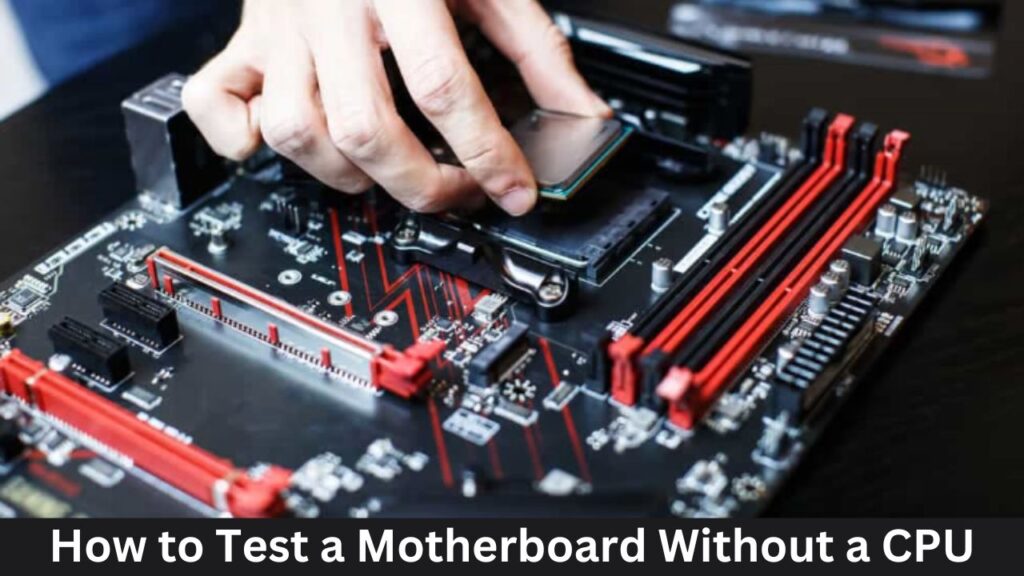Testing a motherboard without a CPU may seem challenging, but it’s entirely possible.
Before spending money on a CPU, diagnose any hardware problems or check that your motherboard is in good condition.
This article will show how to test a motherboard without a CPU using basic equipment and methods.
Ensure you work in a static-free area and exercise caution when handling electronic components.
Your computer’s motherboard is the central hub to which all the other components connect. If the motherboard is not working properly, your computer will not start. There are a few easy techniques for testing a motherboard without a CPU.
Equipment You’ll Need
Before getting started, gather the following tools and materials:
- Motherboard: The motherboard you want to test.
- Power Supply Unit (PSU): Ensure it’s compatible with your motherboard.
- ATX Power Supply Tester: This helps to provide power to the motherboard without a CPU.
- External Monitor: To check if the motherboard successfully boots.
- RAM Modules: Necessary for basic system functionality.
- Speaker/Beeper: This will help with error code beeps (if any).
Steps to Test a Motherboard Without a CPU
Follow these steps to test your motherboard without a CPU:
1. Preparing the Workstation:
- Place your motherboard on a non-conductive surface like a wooden table or an anti-static mat.
- Ensure you’re working in a static-free environment. Consider wearing an anti-static wristband.
- Connect your external monitor to the motherboard’s video output.
2. Connect the Power Supply:
- Plug the ATX power supply tester into your PSU.
- Connect the motherboard’s 24-pin power socket to the PSU’s 24-pin ATX power cord.
- Connect the 8-pin or 4-pin CPU power cable (if your motherboard requires it).
- Ensure the power supply (the switch on the back) is switched off.
3. Install RAM:
- Insert at least one RAM module into the motherboard’s RAM slots. Refer to your motherboard manual for the correct slot configuration for a single RAM stick.
4. Connect the Speaker/Beeper:
- You may skip this step if your motherboard has a built-in speaker or error code LEDs. Otherwise, connect an external speaker or beeper to the motherboard’s speaker header.
5. Power On:
- Double-check all connections.
- Turn on the power supply.
- If your motherboard has a power button, you can use it. Otherwise, short the power button pins on the motherboard using a screwdriver or jumper.
6. Monitor the External Display:
- Watch the external monitor for any display output.
- Listen for any beep codes. A series of beeps (if your motherboard has a speaker) can indicate specific issues. Consult your motherboard manual for beep code meanings.
7. Observe LED Indicators:
Many modern motherboards have LEDs that indicate various system statuses. On these LEDs, look for any patterns or error codes.
8. Analyze Results:
- If the motherboard successfully posts (displays information on the screen), this indicates that the motherboard and RAM are likely functioning correctly.
- If you encounter issues, refer to your motherboard’s manual and any error codes or beeps for troubleshooting guidance.
9. Power Down and Disconnect:
- Turn off the power supply.
- Disconnect all cables and components.
Additional advice for evaluating a motherboard without a CPU is provided below:
- Verify that the power supply is turned on and that the power wires are attached to the motherboard securely.
- Check for any bent or damaged pins on the motherboard.
- Use the appropriate settings on your multimeter if you’re using one.
- If you use a speaker, ensure it is properly connected to the motherboard.
Consult a knowledgeable professional if you need any additional assistance testing your motherboard.
Conclusion:
Testing a motherboard without a CPU is crucial in troubleshooting when you suspect motherboard issues or want to ensure it functions before buying a CPU.
You can learn more about the condition of your motherboard by following these instructions and paying attention to error codes, LED indications, and display output.
Consult your motherboard’s manual for specific information and seek professional help for complex problems. Comment here.
Also read: What Is Normal Motherboard Temperature?

